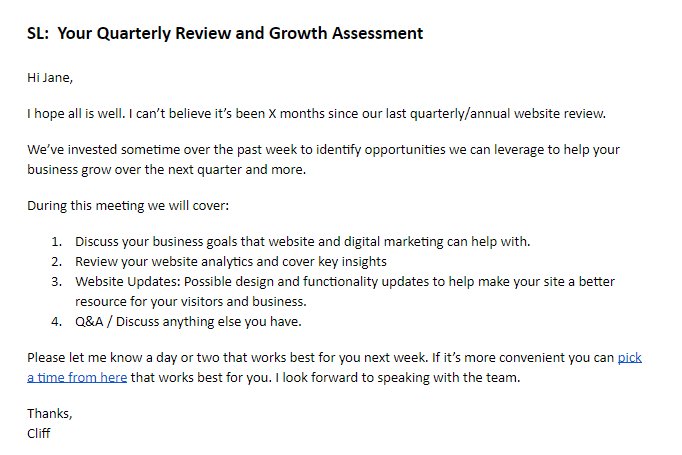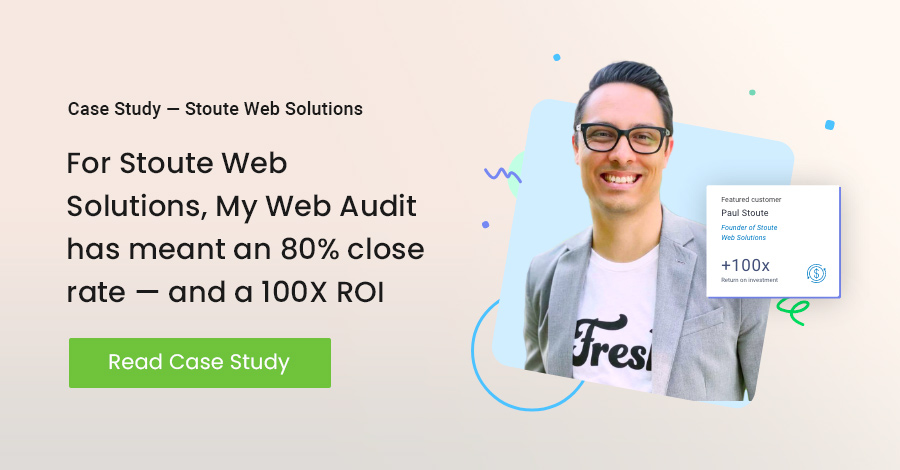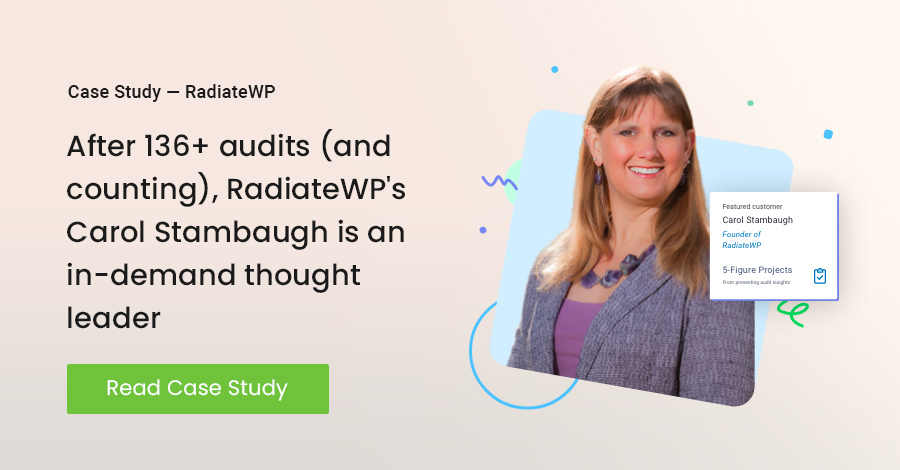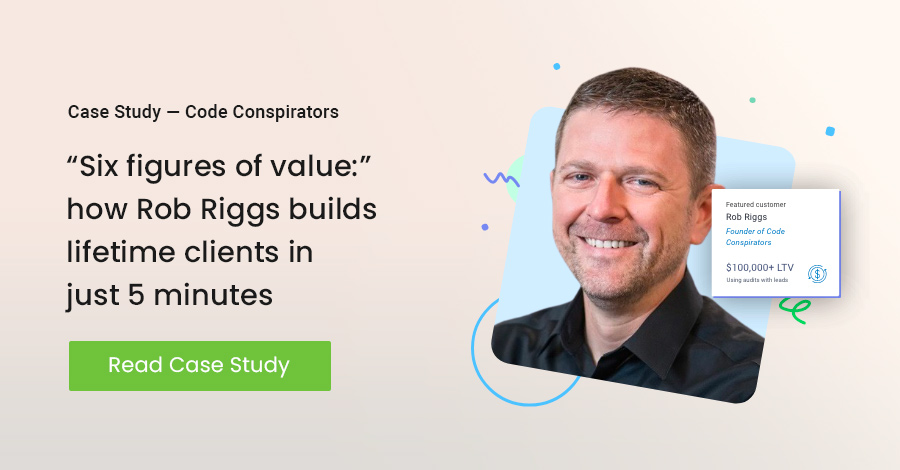
Agency guide to quarterly or annual client reviews
One of the best things we do in our agency is to hold quarterly and or annual strategy sessions with our clients. If you're not currently doing this in your agency, I'd highly recommend you start as soon as possible. These sessions provide a lot of value for both you and your client.
In just a few moments, you'll discover exactly how we run these sessions (in person or via Zoom), what prep work we do before the meeting, and the steps we take after the meeting to generate more revenue and help our clients achieve better results.
But before we dive into those details, let's first take a closer look at why you should be doing these strategic sessions with your agency clients.
What are the benefits of quarterly or annual client strategy sessions?

The big reason we do these meetings with our clients is that they provide a lot of benefits for both our agency and our clients. Here are the key benefits:
Demonstrates commitment
What we’ve realized is that in our agency our ideal clients aren’t looking for the sort of relationship where they place an order for services, and we perform the task. Instead, we’ve found that they want to build relationships with our agency, and this sort of relationship starts with us showing our concern for their business and commitment to helping them with their pain points or desired outcomes like growth. I’m guessing this applies to your agency as well. Your strategy sessions help demonstrate commitment, by showing your clients areas of opportunity they could be focusing on to gain a competitive advantage and better results.
Adds value by being proactive
You’re the expert, you should not be waiting for your clients to tell you what they want and need. Instead, you need to be proactive by pointing out challenges and opportunities, which provide a lot of value to the client.
These meetings can also help uncover opportunities for your business. For example, we were recently on a call with a client who had decided to cancel all print ads in the coming year and had some extra money in their budget they wanted to invest to grow their business. We were able to show them growth opportunities with Adwords and content marketing, which convinced them to invest some of that money in a new digital marketing retainer. A few months ago we had a non-profit we work with invest in additional services in a similar with additional grant money they had leftover.
Helps you understand their business better
Another good reason to initiate annual or even quarterly meetings is because it helps you understand their business better. You can understand where they’re currently at, what they’re doing, and where they want to be. This helps you develop forward-thinking solutions, and both informs and influences their decisions and budget.
When you work with your client on a regular basis like this, they stop thinking of you as a “service provider” and start thinking of you as a partner. This shift alone is a big benefit in developing good relationships and client loyalty.
Builds top of mind awareness
If you don’t stay top of mind with your clients, they tend to get a case of “out of sight, out of mind.” That’s why these meetings are so important, as they build top-of-mind awareness. When your clients have a problem in your domain of expertise, they’re going to think of you first.
Another benefit is that these meetings bring to your client’s attention to your services that they haven’t yet used. For example, if you’ve done web development work for your client, they may think of you as a “web developer.” Unless you remind them of your lead-generation services, they may not remember or even realize that you can help them with services like SEO, social media marketing, email marketing, and more.
In other words, these meetings ensure you’re proactively looking for ways you can help your clients with their pain points and desired outcomes.
Generates revenue and increases customer lifetime value
As I mentioned, when you’re a trusted partner rather than an order-taker, it helps boost client loyalty. In turn, this increases customer lifetime value and revenue.
What we find is that we not only boost revenue in the short-term, as these meetings help uncover growth opportunities that our clients want to work on immediately. They also help increase revenue over the long term, because of the benefits mentioned above, such as building top of mind awareness and cross-promoting other services.
Meeting agenda

You can see that there are plenty of benefits to doing these quarterly or annual meetings with your clients. We follow a specific structure for the meetings that has proven to be really effective. Here’s a typical meeting agenda:
Review quick wins
The first order of business is to remind the client of their wins over the last quarter or last year related to the services we provide them with. At this point, you’re basically looking back on where the client started so that you can celebrate the growth you’ve helped them achieve in the last quarter or year. When it comes to growing companies we work with we track every form submission, click-to-call mobile call, and key actions on a website and report on them each month. This makes it easier for us to quantify the value we deliver and oftentimes leads to our clients praising us because of the results we’ve delivered. We often start by asking them about wins on their end because it’s much more effective for them to tell us about how their business has been impacted from their perspective than to talk about how many leads or sales we generated for them. For example one of the most recent wins we had from a client is we help them to grow into one of the top 50 businesses in their industry nationally. They were not even in the top 100 when we began working with them years ago.
Discuss growth goals
The first point looks back and moves toward the present time. This next point on the agenda is all about starting at the present time and looking forward. For example, you’ll want to discuss with the client their goals for the next quarter or year. Since we are an agency focused on helping businesses grow, primarily focus on goals related to revenue, how many leads they’ll need to generate to meet those revenue goals, and what sort of budget they’ll need to invest in your agency services and platforms like Google or Facebook to generate those leads.
It’s important to ask them about what else is going on in their business. Often times your client may not share information they think isn’t pertinent to your business or services but they actually are.
Over the years we’ve had clients we’ve designed websites for, tell us about their need for email automation, database application, mobile apps, rebranding, and more. In many cases this led to us telling them we offered the service and earned the business and in other instances, it helped us proactively reach out to the vendors to see how we can help them and our clients. That in turn led to us looking like rockstars to our clients and us building some great relationships with companies that offered complementary not competitive services to our agency.
Present opportunities
The next step is to present growth opportunities to your client. For this step, I like to gather information from Google Analytics, pull Google My Business insights, and do a few different audits. Usually, we cover the following: website audit, on-page SEO audit & Google My Business (GMB) audit. These reports help us present challenges that they can address to continue to gain a competitive advantage and help them grow.
For example, the audit might reveal issues with slow page speed and poor conversions on a service or landing page we built out a year ago. We can create a report detailing these key points and present them to the client as opportunities for helping them meet their growth goals.
We like to research and compare our client’s online presence to industry leaders locally and nationally so that they are doing better in as many areas as possible. We’ve found this to be a compelling way to get the clients who feel they are doing good enough to say “Yeah, we need to make sure we are doing better online than John’s company.”
Q&A + next steps
The final point on the meeting agenda is to give your client an opportunity to ask any questions about what they’ve just learned, and then present the next steps. This means telling your client how they can leverage the opportunities you presented to them, as well as inform them about a timeline and the estimated investment to move forward.
Now let’s take a look at what you need to do to get ready for this type of meeting…
Prep work

The key point you want to focus on as you prep for your meeting is to connect the client’s pain points or desired outcomes with your services. Through the information, you present in these meetings you’re letting your clients know you understand their issues, and that you’re also the expert who knows how to solve them. Remember you aren’t selling services you are offering solutions.
Here are the steps you need to take to get to the point of being able to do this effectively:
Reviews pains, desires, and goals
For this step, you’ll want to look back at your notes from previous emails and meetings, as well as any notes you’ve entered into your customer relationship management platform. Be sure to talk to your team about any pain points or goals they’ve picked up on that didn’t make it into the notes.
Identify wins
Your next step is to identify all the wins you’ve helped your client achieve over the last quarter or year. Be specific with your data here. Don’t say, “We helped you generate more leads.” Instead, list exactly how many leads you generated, and how much revenue these leads should have created for the business. We know this because we ask our clients what each lead on average is worth and what their close rate is etc.
Review analytics
Next, review the analytics to identify areas where your client could be doing better. For example, perhaps the client’s site is getting a good amount of traffic, but this traffic isn’t converting into leads or sales on specific service pages. You’ll want to identify the specific issues and present some solutions. In this example, it could be that a majority of the traffic is coming from mobile devices but the page is not optimized for mobile or the page speed is slow because of a few large images that weren’t optimized.
Run and customize audits
The next step is to create custom audits for the client. The key here, again, is to run audits like these based on your client’s specific pain points and desires. For example, if one of your client’s big issues is that they need more leads and their site is virtually invisible in Google, then run a Google My Business Audit and SEO audit to address this pain point.
Once you’ve gathered all this information, then you can get ready to present it.
Pro Tip: We are able to run and generate website audits, on-page SEO audits, GMB audits, Page Speed audits, and more in minutes using My Web Audit. This app helps our agency build trust faster and close more—and bigger—deals with beautiful, actionable, and easy to understand website audits.
Presenting insights

After years of trial and error, I’ve figured out how to present this information in a way that hold’s the client’s attention and persuades them to invest money with the agency to help them fix these issues.
Here’s what I’ve learned:
Measure what matters
Sure, you can measure just about anything when it comes to business analytics and audit points. But in order to create a presentation that’s effective, you want to measure what’s most important to your specific client. Again, tie your audit and presentation into their pain points, and you’ll have their attention.
Remember you’re selling solutions to business problems. And you’re going to have a much easier time doing that when you can provide visibility into the true problems they are having with their website—So if you realize they get a lot of mobile traffic stop selling them a “beautiful” site and start selling them a responsive design that will help them better convert the 42% of traffic that’s coming to them on a mobile device that is currently bouncing due to a poor user experience.
Prioritize based on impact
Your client likely doesn’t have a bottomless budget, which is why you need to prioritize growth opportunities based on impact. In other words, give your clients the most bang for their buck, by starting with the issues that are going to present the best opportunities for growth. The goal is quick wins to help them continue with a long term investment in your services.
Present in a way that’s easy to understand
While you’re working on issues like the technical aspects of SEO or page speed optimization every day, most of your clients know nothing about the technical side of things. Consider this as the proverbial sausage-making: your client wants the benefits, but they don’t care to know exactly how you deliver those benefits.
Point is, keep your presentation simple and not technical. Don’t overwhelm them with dozens of points. Your goal is to show your client that you know what you’re talking about, why it matters, and for them to understand that you are the trusted expert who can help take care of it all for them.
What is great about MyWebAudit.com (the platform we use) it creates a beautiful PowerPoint with all the talking points for us. It even prioritizes what it finds and it’s in language that our clients can understand!) You can check out the reports it generates here.
Now let’s look at how to improve the effectiveness of your presentation.
Free audit templates to get more leads & close more deals
Easily personalize and use our proven templates for free today. Use to deliver value and build trust with your prospects.
Talking points

Again, let me remind you that your main goal is to connect your audit and presentation with the client’s pain points and desires. I’m not sure who your audience is or what services you offer but in our agency, we usually work with large non-profits or 7&8 figure businesses looking to grow their business online. So we have a simple framework, where we tie our talking points to the following areas we know our clients care about the most:
Saving time
It doesn’t matter what your client’s main pain points or desires are: if you can find a way to help them save time, they’re usually going to be very interested in what you’re offering. To that end, think about what sort of apps and automation you can introduce to your client to help them save time.
Brand awareness
Smaller businesses and non-profits we work with are always looking for effective ways to increase their brand awareness. In the past, we’ve discussed using Google grants for non-profits to do exactly that and use the $5 a day paid campaign on FB to help build brand awareness for local businesses and even generate some leads along the way. These have led to big wins for our clients.
More leads and sales
This talking point is what every business owner wants to hear about. So, for example, if you’re talking about increased visibility in search engines like Google, then be sure to tie that to more leads and sales.
Avoid these mistakes

You can tank your presentation pretty fast if you make any of the three common mistakes mentioned below.
Offering too much detail
If you offer too much detail to the client, you’re going to overwhelm them and probably lose their attention. Seeing your client’s eyes glaze over is about the last thing you want to see during a strategy meeting, so keep your presentation focused on the most important points.
Using technical detail
This goes back to the whole “sausage-making” analogy. Your client doesn’t care about the technical details and they probably don’t even understand them. That’s why you need to focus on their desired outcomes.
For example, you’ll bore or confuse your client by telling them how they need to leverage browser caching and remove render-blocking JavaScript.
Instead, focus on the outcomes: tell them in simple terms that the goal is to increase their page speed, which in turn improves visitor experience, engagement, and conversions.
Avoid discussing unfamiliar topics
The third thing to avoid is discussing topics with which your client is unfamiliar. If they start asking questions about this unfamiliar topic, you can end up derailing the entire point of your meeting.
Remember these important points

At this point, we’ve talked about the meeting agenda, the prep work, and the talking points to incorporate into your presentation. Now let me quickly recap the most important points for you to remember:
Schedule the call
Your first step is to schedule the call with your clients. The end of the year or the start of one is a great time to do this, as most business owners are reviewing the past year and planning for additional growth.
Here is the email template we use to schedule this call:

Connect with pain points and desires
If you take one thing from this guide, let it to be that you need to connect the client’s pain points and desires with your services. Your presentation should be completely positioned on how you can help them alleviate their pain points and achieve their goals.
Present clear next steps
At the end of the meeting, let your clients know what to expect next. Once the meeting is over, then send an email to your client with a recap of the meeting. I also like to provide a video overview of the key issues they’d like to work on, as well as a timeline and estimate.
Join our agency owners facebook group
If you are interested in topics like agency lead generation, sales, growth, and entrepreneurship join the conversation in our Closed FB Mastermind for Web Professionals and Agency Owners.
Follow up
The final step is to be sure you follow up with your clients and recap the key points and next steps. Here is the template we use to follow up with clients:

Agency sales secret to closing

Before we wrap up this guide, I want to share with you the secret we’ve learned to close more sales. That secret is to utilize GIVE + EAT in your strategy meetings (as well as all interactions with your client).
The GIVE principle breaks down like this:
- Generosity, which is where you’re generous with your time and expertise.
- Information, which is where you provide information to your clients to help them grow their business, such as by pointing out growth opportunities.
- Value, which is all about providing value upfront to your clients to help develop good relationships.
- Education, which is where you educate your clients on how your specific services can help them solve their problems.
The second component is EAT, which is all about building Expertise, Authority, and Trust.
We feel that offering an audit report is the best way to implement the GIVE and EAT principles in your business and start closing more sales. Our audit reports work well because they provide a lot of value upfront, and they detail custom solutions in an easy-to-understand way that leads to the client’s desired outcomes.
If you’d like to start closing more deals too, then please visit MyWebAudit, where you’ll discover a tool that helps you build trust faster and close more—and bigger—deals with beautiful, actionable, and easy to understand audit reports.
Learn more at www.mywebaudit.com.
You may also like

Black Friday + Cyber Monday deals for agencies
Black Friday is the ultimate opportunity for freelancers and agency ow...
Learn more
The Power of One More: Strategies For Running An Extraordinary Web Agency
In the fast-paced world of digital marketing and web design, it's easy...
Learn more




















